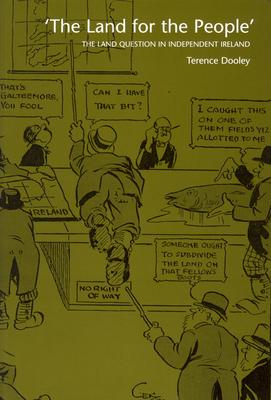The Land for the People
Roy Johnston reviews The Land for the People: the land question in independent Ireland by Terence Dooley, UCD Press, ISBN 1 904558 15 1, 25 euros, £18.95 pbk

THIS BOOK is important in the context of the need to understand the current land question in Ireland, and its relationship with the historical roots of the Fine Gael and Fianna Fail parties.
Basically it traces the work of the Land Commission from its foundation in 1881 up to the foundation of the State in 1923, and then follows its subsequent transformation into a tool for the consolidation of local political mafias, in a complex and convoluted process.
It begins to address the question of who the 'people' were who got the land, and how they relate to the wider concept of the 'Nation', taking a hard critical look at the classic Fianna Fail policy of attempting to maximise the number of viable 'family farms', in the light of both contemporary and retrospective experience.
It is difficult to do justice to the complexity of the issues in a short review; the best I can do is highlight a few focal points in the argument, like the perceived feeling in the Dail that they were actually reversing Cromwell's policy by relieving 'congestion' in the west by giving people the chance to move to land in the east taken from the despised 'graziers'.
Some movement from the west did take place, and many people got land, as a consequence of the division of the landed estates. But each episode was bedevilled by conflicting interests between locals and migrants, and the resulting patchwork of subsistence holdings was a long way from being a network of viable communities. The people who got the land were in fact a relatively small minority group within the nation, and mostly did not have the capital or the knowhow to work it effectively.
It would have made much more sense if the land of Ireland had in fact been vested in the people of Ireland via the state, as Michael Davitt advocated, and then leased out to those who knew how to work it, preferably in co-operative groups in a position to take advantage of the synergies possible in large-scale operations.
Economic analysis done in the 1930s, by my father Joe Johnston and others, demonstrated that large-scale labour-employing commercial estates were about twice as productive per man and per acre than were the typical sub-divided Land Commission holdings. The analogy in industrial terms is to carry out an industrial reform in which every worker gets his own mini-workshop. No-one in his right mind would advocate this. Production is essentially a social process. Yet it was seriously thought by the early agrarian reformers that the alternative to the landlord-owned estate was subsistence peasant farming, with the consequence that during the war we were on the verge of starvation.
Dooley analyses how the Land Commission related to successive governments, and how the local Fianna Fail and Fine Gael mafias influenced land division policies, in such a way as to copper-fasten their local political support. Land in fact was used to feed a process of political corruption, and the people who got to own the land as a result are now in a position to perpetuate the process of political corruption, as a result of the current practice of allowing the added value on re-zoning to accrue to the land-owner, instead of to the local authority representing the community. Whence the universality of the culture of the 'brown envelope' in local politics.
The differing attitudes of FF and FG to 'undoing Cromwell's work' is illustrated by the fact that during the first decade, large farms in the west were moved east, and their land given to locals, while after 1932 local smallholders were moved in colonies.
The role of the Land Commission in fact came to an end after 1972, with the entry to the EEC; the price of land rocketed, and it became politically impossible for the State to buy it at the market price for a perceived social resettlement process, of which the economic value was increasingly being seen as questionable.
There is only one passing reference to Horace Plunkett and likewise one, unrelated, to the Irish Agricultural Organisation Society; in neither context is there any reference to the existence of the co-operative movement. The way the land reform went has resulted in the vision shared by Plunkett and George Russell, and also by James Connolly in his Reconquest (see the Ralahine chapter), being totally forgotten, to the extent that an important book like this can, in effect, write the alternative co-operative vision out of Irish history.
Historians of the co-operative movement (Bolger and others) have done their stuff, but the problem of how to integrate an individual family farm culture willingly into a synergetic bottom-up reconstruction of a productive large-scale commercial managed estate remains with us. The 'land ownership' culture imposed by the Land Acts remains with us, to blight our food production system.
This book however will help us to understand how the rural political mafias work, and in that context it is welcome and should be read.
Connolly Association, c/o RMT, Unity House, 39 Chalton Street, London, NW1 1JD
Copyright © 2005 Roy Johnston

